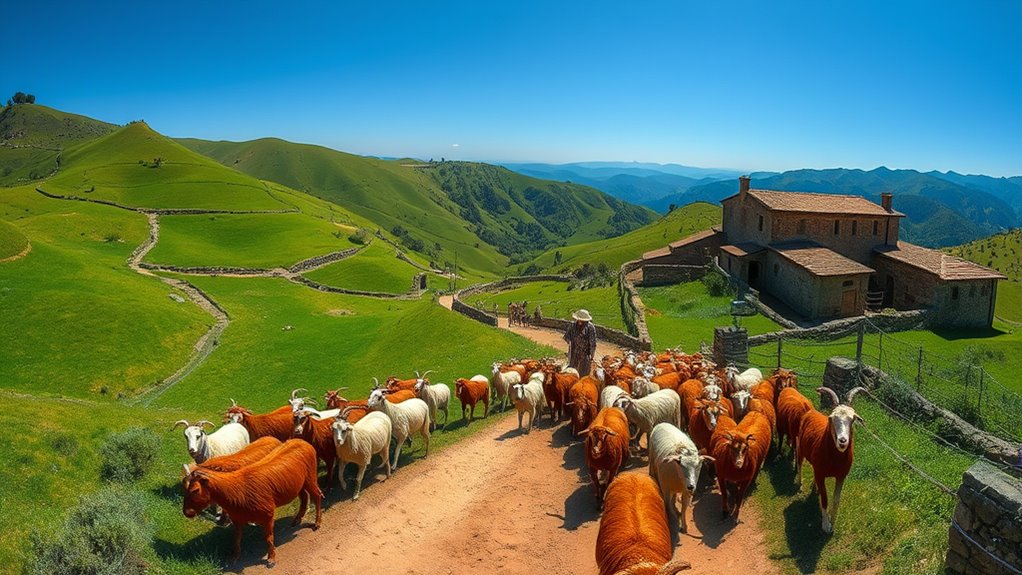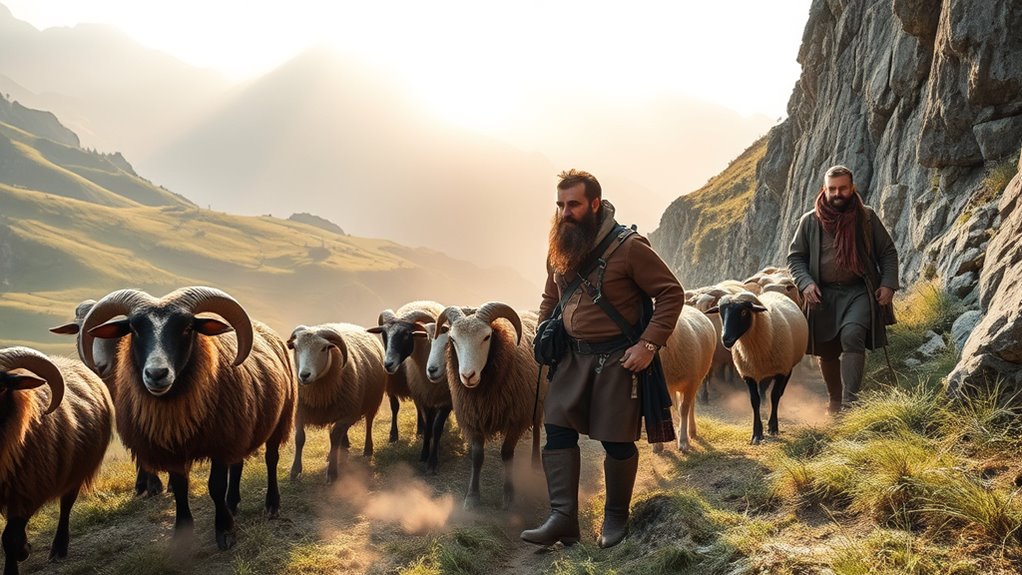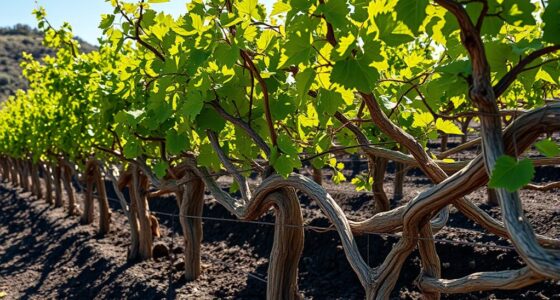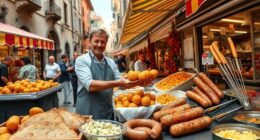Transhumance is an age-old Italian tradition where you see herders moving livestock seasonally between mountain pastures and valleys. This practice helps maintain land health, promotes ecological balance, and supports local communities. Routes are passed down through generations, reinforcing cultural bonds. It’s a harmonious way humans work with nature to ensure resilient animals and lush lands. To discover how this centuries-old tradition continues today and shapes Italy’s landscapes, keep exploring further.
Key Takeaways
- Transhumance is a centuries-old Italian practice of seasonal livestock grazing between alpine pastures and valleys.
- It follows traditional routes, synchronized with seasonal climate and pasture availability, ensuring sustainable land use.
- The practice supports ecological balance by preventing overgrazing and promoting biodiversity.
- Transhumance fosters community bonds, preserves cultural heritage, and sustains local crafts like cheese-making.
- Modern transhumance symbolizes harmony between humans and nature, maintaining Italy’s rural landscapes and cultural identity.

Have you ever wondered how traditional Italian herders move their livestock across the mountains? The answer lies in the centuries-old practice of transhumance, a seasonal grazing system that has shaped Italy’s rural landscape. During the warmer months, herders lead their flocks to higher alpine pastures, while in winter, they bring them back to lower valleys. This pastoral migration isn’t just about finding fresh grass; it’s a carefully coordinated routine that sustains local economies and preserves cultural heritage. You might picture herders guiding sheep, goats, or cattle along rugged mountain trails, but what truly makes transhumance special is its seasonal rhythm. Each year, herders plan their migrations around climate, pasture availability, and traditional routes, ensuring livestock always graze on the most nutritious forage available. This cyclical movement helps prevent overgrazing in any one area, maintaining the health of the land and supporting biodiversity.
By participating in seasonal grazing, herders also adapt to changing weather patterns, making their livestock resilient to environmental shifts. These migrations often follow established routes passed down through generations, reinforcing a deep connection between people and land. The pastoral migration isn’t a random trek; it’s a strategic journey that aligns with the natural cycle of seasons, allowing herders to optimize grazing conditions while minimizing the need for supplemental feed. You can imagine the sense of community that forms around these migrations, with families and neighbors sharing knowledge, assisting in herding, and celebrating the arrival at each new pasture. This collective effort also helps sustain local economies, as transhumance supports cheese-making, dairy production, and other traditional crafts.
Additionally, the practice of transhumance contributes to land management by encouraging sustainable grazing practices that balance animal needs with ecological health. Transhumance in Italy isn’t just a practical solution for grazing; it’s a living tradition that embodies harmony between humans and nature. It shapes the scenic mountain landscapes we admire and keeps alive ancient customs that might otherwise fade away in modern times. You might see herders with their dogs guiding the herd through narrow mountain passes or along winding trails that have been used for centuries. These seasonal migrations foster a deep sense of identity and continuity, connecting present-day communities with their ancestors. Ultimately, transhumance’s seasonal grazing and pastoral migration serve as a testament to Italy’s commitment to preserving its rural traditions while adapting to the evolving environment. It’s a remarkable dance with nature’s rhythms that continues to define the country’s cultural landscape today.
Frequently Asked Questions
How Has Transhumance Influenced Italy’s Regional Cultures?
You can see that transhumance has deeply shaped Italy’s regional cultures by fostering cultural preservation and enriching culinary traditions. As you explore different regions, you notice how ancient herding routes influence local festivals, music, and crafts, strengthening community ties. This seasonal movement also introduces unique ingredients and recipes, preserving culinary heritage and promoting local identity. Through transhumance, Italy maintains its diverse cultural tapestry, celebrating centuries-old customs that continue to thrive today.
Are There Modern Adaptations to Traditional Transhumance Practices?
Yes, modern transhumance adapts with digital technology, helping you track livestock routes and communicate efficiently. You might also see sustainable tourism initiatives that let you experience traditional practices firsthand while promoting environmental preservation. These adaptations keep the tradition alive, blending age-old methods with innovative tools. As a traveler, you can enjoy authentic cultural experiences that support local communities and respect their natural landscapes.
What Are the Environmental Impacts of Transhumance in Italy?
You might notice that transhumance promotes sustainable grazing, which helps prevent overuse of land and supports healthy ecosystems. It also fosters biodiversity preservation by maintaining traditional grazing patterns that protect native plant and animal species. However, if poorly managed, it can cause soil erosion or habitat disturbance. Overall, when practiced responsibly, transhumance benefits the environment by balancing livestock needs with ecological conservation.
How Do Local Communities Benefit Economically From Transhumance?
You benefit economically from transhumance through increased income, job creation, and sustainable tourism. This tradition supports communal livelihoods by promoting local markets, crafts, and food production. As herders and artisans collaborate, they sustain regional economies, preserve cultural heritage, and attract visitors. The economic benefits extend beyond individual herders, fostering community resilience and ensuring that transhumance remains a essential part of local life and economy.
What Challenges Do Herders Face in Contemporary Transhumance?
You face challenges like climate change, which alters traditional grazing routes and timing, making transhumance less predictable. Livestock health also becomes a concern, as changing weather patterns can lead to disease or poor nutrition. These factors strain your resources and require you to adapt constantly. Despite these difficulties, you continue the practice because it sustains your culture and connects you to the land, but resilience and flexibility are essential for survival.
Conclusion
As you witness Italy’s ancient transhumance, you see more than just livestock moving; you see tradition alive amid modern change. It’s a dance between history and progress, where timeless pastoral routes contrast with busy towns and bustling cities. This seasonal drift reminds you that some customs, like the land’s gentle migration, endure despite life’s rapid pace. In this timeless rhythm, you realize that tradition and innovation can, together, shape a future rooted in the past.









